What is a general description of zone defense in basketball
Zone defense is a type of basketball defensive system that consists of each defender guarding a certain area on the court and by extension, any offensive player that enters into that zone defender’s respective area, ultimately to limit dribble penetration, restrict low post scoring opportunities, and influence jump shots, particularly from offensive teams with below average perimeter shooting abilities.
What is general information about naming conventions for zone defenses
In terms of naming conventions, zone defenses are indicated by a dash (-) between two digits or by two dashes between two sets of digits.
If a zone defense has a dash between two digits, then the digits to the left of the dash would represent the number of zone defenders at the front (or top) of the zone while the digits to the right of the dash would represent the number of zone defenders at the back (or bottom) of the zone.
For example, the phrase “2-3” as in 2-3 zone defense, means that this zone will have two defenders at the front of the zone and three defenders at the back of the zone.
Similarly, if a zone defense has two dashes between two sets of digits, then the digits to the left of the first dash would represent the number of zone defenders at the front, followed by digits to the right of the first dash representing the number of zone defenders in the middle.
Afterwards, there would be a second dash followed by a digit to the right of that same dash which would represent the number of zone defenders at the back of the zone.
For example, the phrase “1-3-1” as in 1-3-1 zone defense, states that this zone will have one defender at the front of the zone, three defenders in the middle of the zone, and one defender at the back of the zone.
Furthermore on a side note, all of the digits will sum up to the number 5, which represents the number of defenders on the court. For example, “1-3-1” would be equivalent to the simple addition operation “1 + 3 + 1” which equals 5.
What are the positions of the zone defenders
The positions of the zone defenders are typically assigned as guards, forwards, and a center. Furthermore, these positions are usually indicated by the alphanumeric characters X1, X2, X3, X4, and X5.
The alphanumeric character X1 is generally given to the defensive point guard and this defender is typically positioned at the front of most zones.
The alphanumeric character X2 is generally given to the defensive shooting guard and this defender is usually positioned near one of the wings but could also be positioned at the front of some zone defenses such as the 2-3 zone, alongside the defensive point guard X1.
The alphanumeric character X3 is generally given to the defensive small forward and this defender is usually positioned near the opposite wing of X2 or at the back of the zone near one of the short corners. However, in the case of the 1-3-1 zone, this defender is sometimes positioned at the front of that particular zone.
The alphanumeric X4 is generally given to the defensive power forward and this defender is usually positioned at the back of the zone near the short corners but could sometimes be positioned near the wings with certain zone defenses.
Lastly, the alphanumeric character X5 is generally given to the defensive center and this defender is usually positioned at the back of the zone near one of the post blocks but could sometimes be positioned at the mid-line or near the basket, as in the case of the 2-1-2 zone or 2-3 zone respectively.
What are advantages of zone defense
Influence jump shots from below average shooters
One of the strengths of zone defense is its ability to limit or prevent scoring opportunities from teams that do not have an average to above average ability to make perimeter jump shots, particularly beyond the three-point arc.
Influence perimeter passing
If the zone defenders are able to keep the ball away from the weak spots of the zone, which are typically the high post area and/or short corners, then the offense would have no other options but to pass the ball, particularly around the perimeter areas of the court, looking for a good shot as time runs down on the shot clock and/or game clock.
Take away dribble penetration and/or low post scoring opportunities
Essentially, since each defender covers a specified area on the court, it is much more challenging for the offense to attack the rim or execute entry passes, especially to score near the low post areas.
For example, let’s say that an offensive player in possession of the ball attempts to slash to the basket via the middle of the zone. However, let’s also say that one particular zone defender successfully covers that area inhibiting the dribble penetration action.
Moreover, another adjacent zone defender could potentially execute the defensive stunt tactic if necessary, which further limits dribble penetration.
When those types of defensive actions occur, the offensive player in possession with the ball might be influenced into taking an ill-advised jump shot or the offensive player may simply elect to pass the basketball to another teammate, particularly near a perimeter area of the court, which would be beneficial to the defense.
As another example, let’s say that an offensive player in possession of the ball attempts to blow by a zone defender towards the baseline area of the court.
When that happens, two zone defenders who are near that baseline could execute trap defense, which could possibly result in an offensive turnover.
Mitigate offensive exploitation of foul trouble
If a defensive team has one or more players in foul trouble, then the offensive team could exploit that issue by executing certain actions such as isolation plays to create scoring opportunities specifically against the defender in foul trouble.
If that were to happen, then any defenders in foul trouble would be more or less forced to reduce the amount of defensive pressure against certain offensive players, which could lead to easier scoring opportunities for the offensive team.
So, to mitigate this issue, the defensive team could implement a zone defense which would automatically reduce defensive pressure to one degree or another.
Additionally, the zone defense would potentially reduce the effectiveness of the offensive team’s isolation plays or other actions, which again, could be utilized in an attempt to exploit one or more defenders in foul trouble.
Mitigate offensive exploitation of slower defensive speed
If a slower defensive team implements a zone defense as opposed to a man to man defense, then the offensive team will not be able to effectively use their speed advantage because each zone defender covers an area and not a specific offensive player.
For example, let’s say the defensive team is slower than the offensive team so they decide to implement the most common 2-3 zone defense.
Let’s also say the offensive shooting guard, typically indicated as the number 2, used dribble penetration near the wing to get around the defensive shooting guard, X2.
When that occurs, if the offensive shooting guard dribbles toward the baseline, then that same player will inevitably run into X3 or X4 near the short corners.
In similar fashion, if the offensive shooting guard dribbles toward the middle of the zone, then that same player will most likely get stopped by X1.
In addition to that, even if the offensive shooting guard is able to get into the lane, that same player will have to contend with X5 who is covering the middle and protecting the basket.
Therefore, the offensive shooting guard’s main options would be to take a jump shot, which would most likely get contested by one of the zone defenders, or pass the ball to another teammate, who would most likely be near the perimeter.
From that point, if the other teammate who received the ball from the shooting guard takes a jump shot, then that is what the zone defenders wanted anyway.
As another example, let’s say the defensive team implements the 2-3 zone again. Let’s also say the offensive shooting guard has the ball near the wing again.
However, this time, let’s say an offensive player on the weak side of the court decides to cut to the basket for scoring opportunities.
In a man to man sequence, if that weak side offensive player is faster than their defensive counterpart, then this would most likely cause a defensive breakdown to which the cutting player could receive the ball from the offensive shooting guard and score near the basket.
Although, with this particular 2-3 zone scenario, if the cutting player receives the ball from the shooting guard, then that same player will more than likely have to shoot a contested shot over the arms of X3, X4, or X5.
What are disadvantages of zone defense
Ineffective against above average perimeter shooters
A zone defense could become ineffective against a team with one or more above average perimeter shooters, particularly from three-point range.
If the offensive team can efficiently move the ball and cause the zone to shift from one side to the other, then this will most likely result in open jump shot opportunities at some point during the zone defensive sequence.
Therefore, if a defensive team elects to play a zone defense, that team should consider implementing it against offensive teams with below average shooters or the defensive team should have players with the ability to closeout and contest potential jump shots from the offense.
Inadequate if the offensive team is winning the game
A zone defense could become inadequate if the offensive team is winning the game, particularly during crunch time towards the end of the game and/or during segments when the offensive has a substantial lead such as ten points or more.
The main problem for a team that implements a zone defense while being behind is that there will usually not be enough defensive pressure against the offense.
Instead, the offensive team with the lead could simply pass the ball around the perimeter indefinitely without a shot clock or pass the ball until the last seconds of a shot clock.
Therefore, if a defensive team wants to employ a zone defense while being behind in points, then that team may want to consider extending the zone or adding in defensive trapping.
If a defensive team extends the zone, this could produce more pressure on the ball and at the same time, this could potentially lead to rushed or contested jump shots, which would be a boon for the defense.
In similar fashion, if a defensive team implements traps within the zone defense, particularly near the wings or corners, then this could possibly lead to turnovers, which again is beneficial for the defense.
Vulnerable to gap exposure by the offensive team
A zone defense could become vulnerable to breaking down by way of the offensive team exposing and attacking gaps of the zone, which are usually the high post areas and/or the corner areas, especially the short corners.
Essentially, if the offensive team can get the ball into the gaps of the zone, then the zone defense will most likely break down because the zone defenders will not be able to effectively guard the ball and cover their respective areas efficiently.
For example, if the offensive team gets the ball into the middle of the 2-3 zone near the free throw line, then either X1, X2, or X5 has to cover the ball or give up a potential open jump shot.
However, if either of those zone defenders cover the ball, then that means at least one of the other offensive players would be left open for at least a second or two.
So, if X1, the defensive point guard or X2, the defensive shooting guard attempts to cover the ball, then that means their respective counterparts, the offensive point guard or shooting guard would be left unguarded to take potentially open jump shots.
Similarly, if X5 steps up to cover the ball, then X3 or X4 would have to potentially guard at least two offensive players; one near the basket by way of high low action or one near the corners by way of a pass from the middle of the zone to the corner.
In either situation, the offensive team would most likely increase its chances of getting an open jump shot which is bad for the defense.
Susceptible to offensive rebounding
A zone defense could become susceptible to offensive rebounding because each zone defender covers an area and not an actual offensive player.
This means that if one or more zone defenders are not close enough to an offensive player and/or the zone defenders do not quickly and effectively box out adjacent offensive players, then the offensive team will most likely increase its chances of gaining offensive rebounds, which would then lead to second chance point opportunities.
So, to alleviate this potential problem, zone defenders might want to employ a tactic such as a rebounding triangle.
For example, two zone defenders closest to the basket could box out the nearest offensive players and one zone defender closest to the high post/mid-line area could box out an offensive player near that spot on the court.
By doing this, the zone defenders could lessen the potentiality of offensive rebounds and at the same time, gain a few defensive rebounds for themselves.
What are key principles of zone defense
Limit or prevent high post touches
As mentioned earlier, one of the disadvantages or weaknesses of zone defenses are gaps within the zone. This is particularly true at the high post area of certain zones such as the 1-2-2 zone or the 2-3 zone.
Therefore, it is important for zone defenders to limit or prevent opportunities for offensive players to receive the ball at the high post. This is done by executing denial defense with a hand in the passing lane between the ball and the high post offensive player.
Additionally, on-ball zone defenders should have active hands which mirror the hands of the ball handler in an attempt to make any potential high post passes more challenging and/or as a way to deflect the pass and create a possible turnover.
Limit or prevent low post touches
If the ball gets into the hands of a low post player with above average offensive skills, then that player could score quickly and efficiently against the nearest zone defender with a low post move.
This is opposed to what the zone defenders would desire so to alleviate this potential issue, the zone defender who guards that low post area should front the offensive low post player to prevent any easy post entry passes from the perimeter offensive players.
As an alternative option, if the ball does get into the low post, then one of the perimeter zone defenders near the wing or corner could double team the offensive low post player to influence that same player to pass the ball back towards the perimeter.
Essentially, this type of double team strategy could be especially useful if the wing or corner offensive players on that strong side of the ball are below average perimeter shooters.
Limit or prevent dribble penetration
It is possible for the offensive team to attack the gaps of the zone with dribble penetration. If that occurs, then the zone defense could potentially break down which could lead to scoring opportunities for the offense.
So, to reduce the effectiveness of dribble penetration, the nearest off-ball zone defender could execute the defensive stunt.
From that point, the offensive player in possession of the ball could potentially pass to another teammate, and in particular, a teammate on the perimeter.
Following that, the perimeter player could take a jump shot, preferably a contested jump shot, which is what the zone defenders want anyway.
Another way in which zone defenders could limit dribble penetration is by forcing the player in possession of the ball towards the baseline, particularly when that same player is near a wing or corner.
If the player in possession of the ball dribbles toward the baseline, then two of the nearest zone defenders could set a trap and cause a potential turnover as mentioned earlier.
Limit or prevent uncontested jump shots
Although defenders cover specific areas in a zone defense, this does not automatically mean that offensive players can shoot uncontested jump shots. Instead, zone defenders should always try to closeout with good footwork and contest jump shots, even from below average shooters.
By implementing this type of defensive mindset, offensive teams would more than likely shoot lower field goal percentages which would be beneficial to the defense.
Communicate with teammates
Generally speaking, communication is a very important concept in basketball for offense as well as defense. In terms of zone defense, the various zone defenders should communicate with each other about offensive actions such as screens, cutters, and strategies to limit/prevent dribble penetration and/or offensive low post opportunities.
Additionally, defenders could communicate tactics such as defensive rotations as the zone shifts from side to side.
What are the different types of zone defense
The different types of zone defense are known as the 1-1-3 zone, the 1-2-2 zone, the 1-3-1 zone, the 2-1-2 zone defense, the 2-3 zone defense, and the 3-2 zone defense.
Furthermore, these zones are sometimes referred to as even front zones or odd front zones which could be determined by the number at the beginning of the respective zone.
For example, the 1-1-3 zone would be considered an odd front zone because it begins with an odd number while the 2-1-2 zone would be considered an even front zone because it begins with an even number.
1-1-3 Zone Example
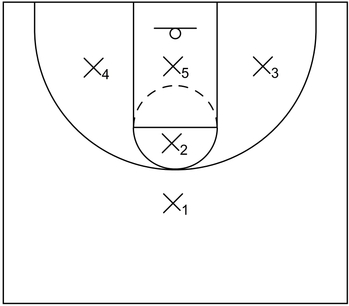
The 1-1-3 zone defense begins with one defender at the front of the zone above the three-point arc, one defender in the middle of the zone near the free throw area, and three defenders in the back of the zone near the basket and low post areas.
1-2-2 Zone Example
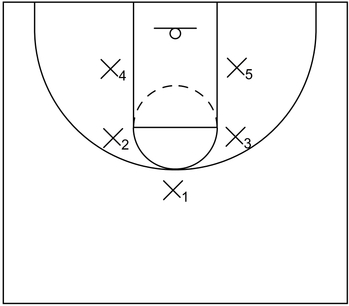
The 1-2-2 zone defense begins with one defender at the front of the zone above the three-point arc, two defenders in the middle of the zone near the high post areas, and two defenders in the back near the low post areas.
1-3-1 Zone Example
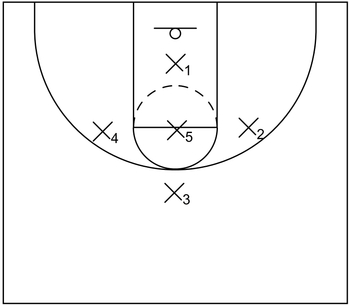
The 1-3-1 zone defense begins with one defender at the front of the zone, three defenders in the middle near the high posts and free throw line, as well as one defender in the back near the basket.
2-1-2 Zone Example
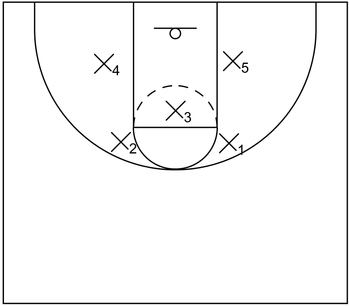
The 2-1-2 zone defense begins with two defenders at the front of the zone near the high posts, one defender in the middle slightly below the free throw line, and two defenders in the back near the low posts.
2-3 Zone Example
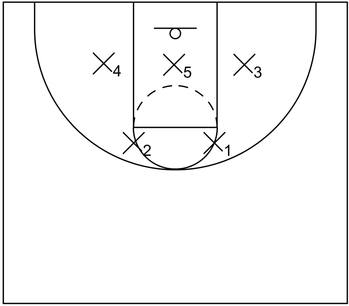
The 2-3 zone defense begins with two defenders at the front of the zone near the high posts and three defenders in the back of the zone near the basket and low post areas.
3-2 Zone Example
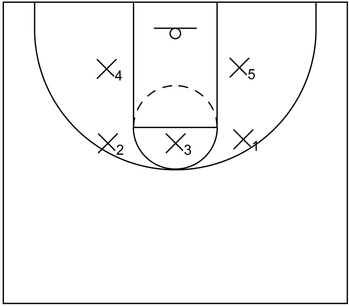
The 3-2 zone defense begins with three defenders at the front of the zone near the free throw line and high posts as well as two defenders in the back of the zone near the low post areas.
What is junk defense
Junk defense is a special type of hybrid defense in which at least one defender covers a specific offensive player regardless if that player controls the ball while the other defenders set up in a zone defense.
Essentially, if the specified offensive player does not control the ball, then the defender who covers that player will execute man to man denial defense and try to stop that player from receiving the ball from teammates.
On the other hand, if the specified offensive player controls the ball, then the defender who covers that player will execute man to man defensive pressure and try to influence a bad shot or cause a turnover from that offensive player.
For example, the most common junk defense known as the box and one, features four zone defenders that cover the high posts and low posts in a box-like formation while one other defender executes man to man defense, particularly against the opposing team’s best offensive player.
Box and One Example
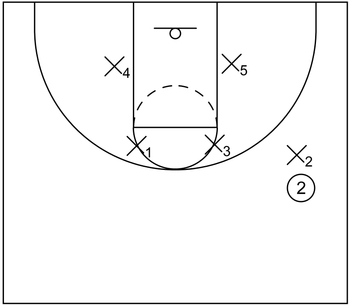
What is match-up zone defense
Match-up zone defense is another unique type of hybrid defense and the main difference between it and the junk defense is that in the match-up zone, at least one defender typically executes man to man defensive pressure against the ball handler while the other defenders set up in a zone defense.
Also, the primary difference between the standard zone defense and the junk defense/match-up zone is that the standard zone defense does not necessarily pressure the ball handler while the junk defense/match-up zone typically involves some type of defensive pressure.
Furthermore, in the match-up zones as opposed to the standard zones, the defenders could deny the passing lanes, particularly on ball reversal.
For example, in the 1-2-2 match-up zone, defensive pressure could be applied immediately to the ball handler at the top in an attempt to disrupt the offensive flow and/or cause a potential turnover.
Additionally, it is also possible to execute denial defense near the passing lanes of wing players to potentially limit offensive scoring options.
When to play a type of zone defense instead of man to man
The best time to play zone defense instead of man to man defense is when the offensive team has at least one, but preferably two, below average long-range shooters.
Another reason to implement a zone defense as opposed to a man to man is when the offensive team has at least one post player with above average post skills that can score around the basket.
In addition to that, a zone defense could be considered when the offensive team has players that are bigger, h3er, and/or faster than the defensive team’s players.
In other words, if the defensive team is undersized and/or possesses slower foot speed, then a zone could be implemented to alleviate one or more of those issues.
When to play junk defense or match-up zone instead of man to man
The best time to play junk defense instead of man to man is when the offensive team only has one or two players that can score consistently and three or four players that have average to below average offensive skills.
The best time to play match-up zone defense instead of man to man is when the defensive team can execute off-ball zone defense principles but quickly switch into on-ball man to man principles when necessary.
In other words, defensive teams that implement the match-up zone would typically have the ability to give some space to non-ball handlers in an effort to limit dribble penetration and/or deny passing lanes.
However, those same zone defenders would be fast enough to closeout, pressure the ball handler, contest possible jump shots, and/or create potential turnovers.
What is bumping within zone defense
Bumping is a technique within certain types of zone defense which occurs when a defender in the back of a zone temporarily rotates to cover the wing areas as a counter to ball reversal by the offensive team and after that, another zone defender that is assigned to the wing area bumps the temporary defender back to their original area in the back of the zone.
Essentially, in some zones, such as the 2-3 zone, the 2-1-2 zone, and the 1-1-3 zone, the weak side wing could become vulnerable when the zone shifts to one side of the court.
For example, if the offense makes a pass to the wing or corner but then quickly reverses the ball to the opposite wing, primarily with skip passes, the weak side wing defender would not have enough time to recover to that spot, in most cases.
If this happens, then the offense could take advantage of that weak side vulnerability by way of dribble penetration or open jump shot opportunities. However, those types of zone defenses could execute bumping to alleviate that potential problem.
Bumping – Example 1
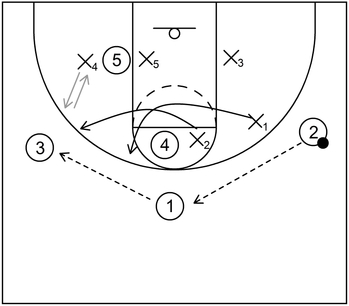
This is an example of the bumping within the 2-3 zone defense. Ball reversal gets executed from the right side of the floor to the left side.
As that happens, X2 probably will not have enough time to recover from the free throw line area to the left side wing. So, to alleviate this problem, X4 temporarily covers the wing area, represented by the gray arrows, and after that, X2 recovers to the left side wing and bumps X4 to the original area in the back of the zone.
Additionally, X1 cuts to the free throw line area and denies the post entry pass.
Bumping – Example 2
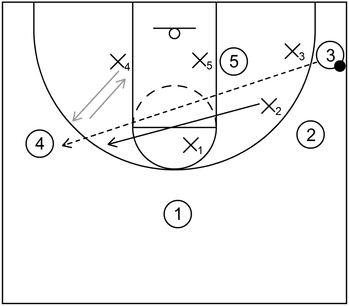
This is an example of the bumping within the 1-1-3 zone defense. A skip pass gets executed from the right side corner to the left side wing.
When that occurs, X2 most likely would not have enough time to recover to the ball. Therefore, X4 temporarily steps up to guard the ball handler, shown with the gray arrows.
Following that, X2 recovers and bumps X4 drops back to the original area at the back of the zone.
What is a full court zone defense
A full court zone defense is technically known as a full court press but each defender still typically covers specific areas similar to the standard zone defenses.
Also, with the full court press, defenders will try to limit or prevent scoring opportunities by trapping or pressuring the ball, particularly in the backcourt, which in turn, could lead to turnovers.
What are tactics the offensive team could use to beat a zone defense
Ball Reversal
The offensive team could execute ball reversal to shift the zone defense out of position. From that point, the offensive team would seek to either dribble into the lane to further break down the zone or simply take open jump shots to score against the zone defense.
However, the zone defenders could counter this with the bumping technique mentioned earlier.
Attack the gaps
The offensive team could attack the gaps of the zone by flashing into the middle of the zone near the high posts or utilizing dribble penetration, particularly with on-ball screens.
Additionally, if the offensive team can get the ball into the middle of the zone, this will open up the high low action, which in turn, could lead to scoring opportunities near the basket.
Therefore, as mentioned previously in the principles section, zone defenders near the high post should try to deny those high post entry passes whenever necessary.
Overload the zone
The offensive team could overload one side of the floor with more offensive players than zone defenders, particularly near the wings, corners and low post.
When that occurs, at least one zone defender will have to cover two offensive players.
This will most likely lead to a scoring opportunity for at least one of those offensive players.
Therefore, as mentioned in the principles section, perimeter zone defenders will have to be ready to closeout when necessary and at the same time, low post zone defenders should always try to front and prevent the offensive post player from getting easy touches near the basket.